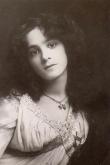Daisy Jerome 'the electric spark' was an eccentric comedienne who toured Australia twice (1913-16 and 1922-23), establishing an extraordinary connection with the country through her appearances in revue, vaudeville and pantomime. Born Daisy Wittowski in New York, ca. 1881, Jerome was raised in England and made her first professional stage appearance as a child. During her teens she appeared in comedy, music hall and pantomime before getting her big break in 1903 as understudy to Ada Reeve in The Medal and the Maid.
Between 1903 and 1913 Jerome toured constantly throughout the UK, and also played engagements in South Africa, Europe, Canada and the USA, and scored much success with the song 'Row, Row, Row.' Jerome came to Australia in 1913 to appear in J. C. Williamson's
Come Over Here (the first ever revue staged in Australia). She later worked for Fullers Theatres and George Willoughby among other firms. Adept at generating her own publicity, and renowned for playing it 'blue,' Jerome scored many song successes in Australia, notably 'Always Take a Girl Named Daisy' 'Follow Me Boys' and 'In the Heart of the City that has no Heart.'
Jerome's return tour for the Fullers in 1922 was one of the most anticipated theatrical events of the early 1920s, and saw the vivacious entertainer's tour become one of their biggest successes of the early 1920s.
[Source:
Australian Variety Theatre Archive]

 6054016807205954480.jpg
6054016807205954480.jpg